Zotac's Ion: The World's First mini-ITX Ion Board
by Anand Lal Shimpi on May 12, 2009 12:00 AM EST- Posted in
- GPUs
Of all of the technologies VIA introduced over the years, I never expected a form factor to be its lasting legacy on the PC industry. The most ubiquitous of VIA’s technologies were its chipsets which are all but gone now - used only by VIA for the most part. VIA’s form factor however, lives on.
The form factor is ITX. Originally introduced by VIA to accompany its line of low-power microprocessors, long before Atom, ITX was designed to deliver much smaller computers than what was defined by the micro-ATX spec.
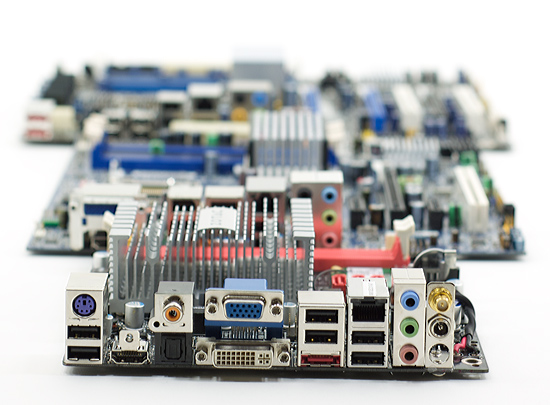
From front to back: Mini-ITX, micro-ATX, ATX
Intel was actually first to market a mini-ITX Atom based motherboard: the D945GCLF. Based on a single-core Atom 230 running at 1.6GHz, the D945GCLF is a relatively simple motherboard.

Intel's first desktop Atom board
It has a single DDR2 DIMM slot supporting up to 2GB of memory (DDR2-400 or 533 only). There’s no support for a modern day GPU, there’s only an old 32-bit PCI slot on the motherboard. You get two SATA and one PATA connector on board, four USB, no DVI/HDMI output (only VGA) and a standard set of three analog audio ports.

The tall heatsink in the back is for the chipset, the small one is all you need for the CPU

As its name implies the D945GCLF uses Intel’s 945G chipset and correspondingly slow graphics. However if you don’t need a ton of performance, Intel’s desktop Atom solution is quite attractive as it sells for under $70 - CPU included (it’s soldered onto the board).
With the quiet introduction of the dual-core Atom, Intel released the D945GCLF2. Nearly identical to its single core predecessor, the D945GCLF2 uses a larger heatsink on the CPU and a smaller one on the GMCH (although it is still cooled by a fan). The board also uses a 24-pin ATX power connector instead of a 20-pin connector, adds S-Video out and a Gigabit Ethernet port (the D945GCLF only has a 10/100 port).
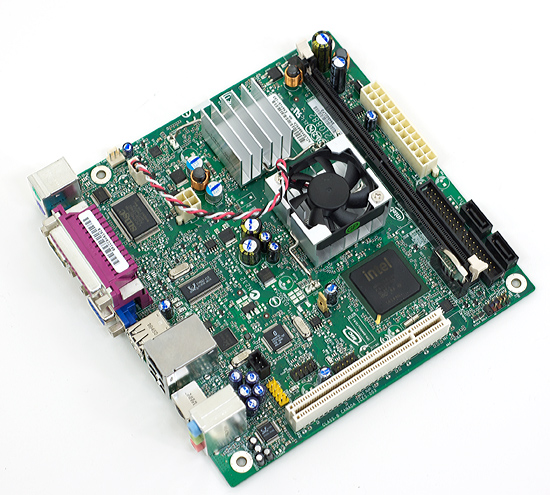
The dual core D945GCLF2 adds a second core to the Atom platform.

Bland ports on the D945GCLF2
The biggest difference is obviously the inclusion of the Atom 330 processor, which is simply two Atom 230 die on a single package - both running at 1.6GHz:
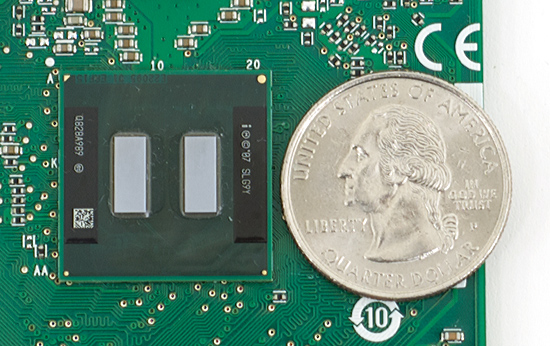
A dual core Atom 330
The faster CPU raises the total price up to $80, still very affordable.
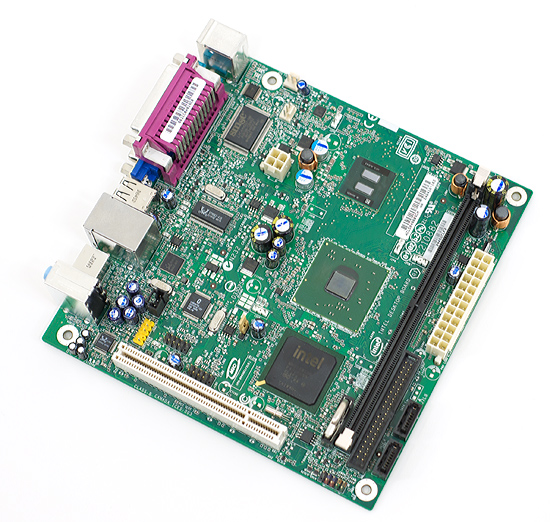
The 45nm Atom processor runs significantly cooler than the 945 GMCH on the board (center chip).
The Intel desktop Atom boards both work just fine but they’re a bit boring. They are reminiscent of Intel’s older motherboards, before it took competition from the tweakable Taiwanese motherboards seriously.
Zotac is the first manufacturer to produce a mini-ITX motherboard based on NVIDIA’s Ion platform. Take Intel’s Atom processor, pair it up with NVIDIA’s Ion chipset (which is basically a GeForce 9300 chipset) and you have the Ion platform.
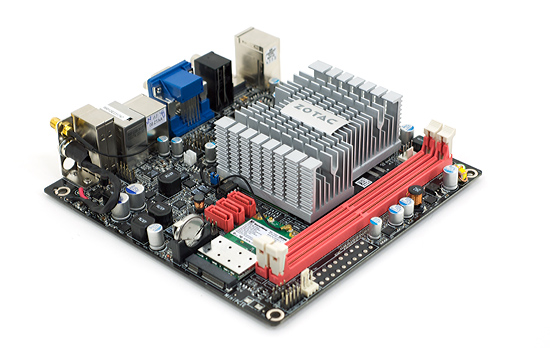










93 Comments
View All Comments
Badkarma - Wednesday, May 13, 2009 - link
Thanks Anand, will definitely drop you a note regarding this over the weekend. It's quite unfortunate that Zotac left out Wake-On-USB for their 9300/9400 mobos, something many consider essential in an HTPC build.djc208 - Tuesday, May 12, 2009 - link
If I didn't have so many projects already I'd seriously consider one of these as the basis of a CarPC system. It's not cheap but a good touchscreen car monitor will run you far more.NNix - Tuesday, May 12, 2009 - link
On page 5: "Once more, the Pentium 4 gets beat by the Atom 330 but loses to the Atom 230"I hope you will review Cortex A8-based Netbooks once they show up. Because Im not impressed at all with Atom, not when looking at <45W dualcore Athlons. Taking into account that those are at 65nm aswell the Atom aint looking that efficient.
nubie - Tuesday, May 12, 2009 - link
I would take a Celeron 420 any day of the week over an Atom or a dualcore athlon ;)GaryJohnson - Tuesday, May 12, 2009 - link
Celery is for eating, not computing.nubie - Wednesday, May 13, 2009 - link
"Celery is for eating, not computing."Sorry, let me be perfectly clear, I would like a Core2 Conroe-L from 1.6-2.0 ghz (every one I have used will easily go over 3 ghz with no voltage increase)
Look at the raw numbers between the Atom and the Conroe-L and tell me on a desktop/stationary machine (IE not a netbook) you wouldn't rather have something more than twice as powerful.
I realize it is called a "celeron", but it is the most freaking powerful (Core2 architecture) Celeron ever sold.
They cost $25-35 on ebay, the LGA 775 version of this board is only $139. It makes a whole lot of sense if you don't plan on running it on battery power.
Not to mention you can move all the way up to a Quad if you want, but a $60 e5200 2.5ghz 2MB Level 2 Cache seems like a perfect match.
Oh, and you get a PCI-e 2.0 X16 slot :P http://www.newegg.com/Product/Product.aspx?Item=N8...">http://www.newegg.com/Product/Product.aspx?Item=N8...
For $10 more it makes a whole lot of sense. (If you already have the LGA 775 chip laying around it makes even more sense.)
npp - Tuesday, May 12, 2009 - link
What could have made this board perfect is a PCI-E slot to stick some decent audio in. Anyone seen mini PCI-E sound cards around :)Visual - Wednesday, May 13, 2009 - link
Why would you want a sound card for any computer made in the last 10 years? Even with the fanciest card, there would not be even one bit of difference on the digital outputs, which are the ones you should be connecting to your receiver. On the analog outputs there will be quality differences indeed, but if you're using them you deserve what you get :p Besides, I get the feeling you wouldn't notice the difference anyway as if you're that stupid to be using them you are also probably using some crappy speakers.flipmode - Tuesday, May 12, 2009 - link
"Everyone seemed to want a Ion based motherboard after I first previewed the platform."Yeah, it is all because of you :roll:
Is that x264 encoding that you used to test power consumption? Why that? The most power draw likely comes from the chipset. Test Blu-Ray playback or something.
Pandamonium - Tuesday, May 12, 2009 - link
The first comment was pretty rude and uncalled for, I must say.I wanted to see an Ion-based HTPC after the preview and this article confirmed that an Ion-based HTPC is what I should set my sights on next. The only improvement Zotac could have made is to include a PCIe slot for TV tuners, audio, or beefed up video. A higher rated Atom would be nice too, but I don't even know that one exists.